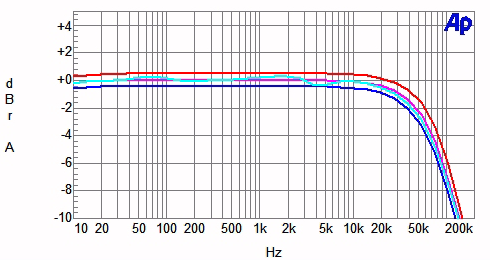Power output with 1kHz test signal
- 8-ohm load at 1% THD: 141.3W
- 8-ohm load at 10% THD: 173.1W
- 4-ohm load at 1% THD: 213.4W
- 4-ohm load at 10% THD: 266.6W
General
The Oracle SI 1000 is a remote-controlled, medium-power
solid-state integrated amplifier. Overall gain of this unit is about right for a modern
integrated amplifier -- a bit higher than average power-amp-only gain.
Chart 1 shows the frequency response of the amp with
varying loads. This plot was made with the reference volume-control position as set for
0.5V input to produce 5W output into an 8-ohm load. The high-frequency response is
moderately wide, with an approximate 3dB-down point of about 60kHz. Output impedance as
judged by the closeness of spacing between the curves of open-circuit, 8-ohm and 4-ohm
loading is somewhat high for solid-state power amplifiers. Still, the variation with the
NHT dummy speaker load is only of the order of +/- 0.25dB -- it’s not going to make
much of an audible difference with most speakers. Of note, the high-frequency roll-off
shape is nicely independent of loading. The frequency response of this unit was quite
independent of volume-control setting. Tracking between channels was within about 0.1dB
from full up to -70dB of attenuation.
Chart 2 illustrates how total harmonic distortion plus
noise vs. power varies for 1kHz and SMPTE IM test signals and amplifier output load. Not
typical of most solid-state amplifiers, distortion maximizes right in the typical
listening range of power output, in the 1-5W range.
Total harmonic distortion plus noise as a function of
frequency at several different power levels is plotted in Chart 3 for 4-ohm loading. The
amount of rise in distortion at high frequencies is quite pronounced, with some rise at
the very low frequencies at 200W output.
Damping factor vs. frequency is shown in Chart 4 and is of
a value and nature not typical of most power amplifiers -- being relatively low and
uniform over most of the audio range. As mentioned earlier, the output impedance is
relatively high for a solid-state power amplifier, yielding a damping factor of about 20.
A spectrum of the harmonic distortion and noise residue of
a 10W 1kHz test signal into 8 ohms is plotted in Chart 5. The magnitudes of the AC-line
harmonics are moderately high and complex in nature. However, intermodulation components
of line harmonics with signal harmonics are low. Signal harmonics consist of a tapering
off spectrum of even and odd harmonics.
![[SoundStage!]](../../titles/sslogo3.gif) Home Audio
Home Audio ![[SoundStage!]](../../titles/sslogo3.gif) All Contents
All Contents



